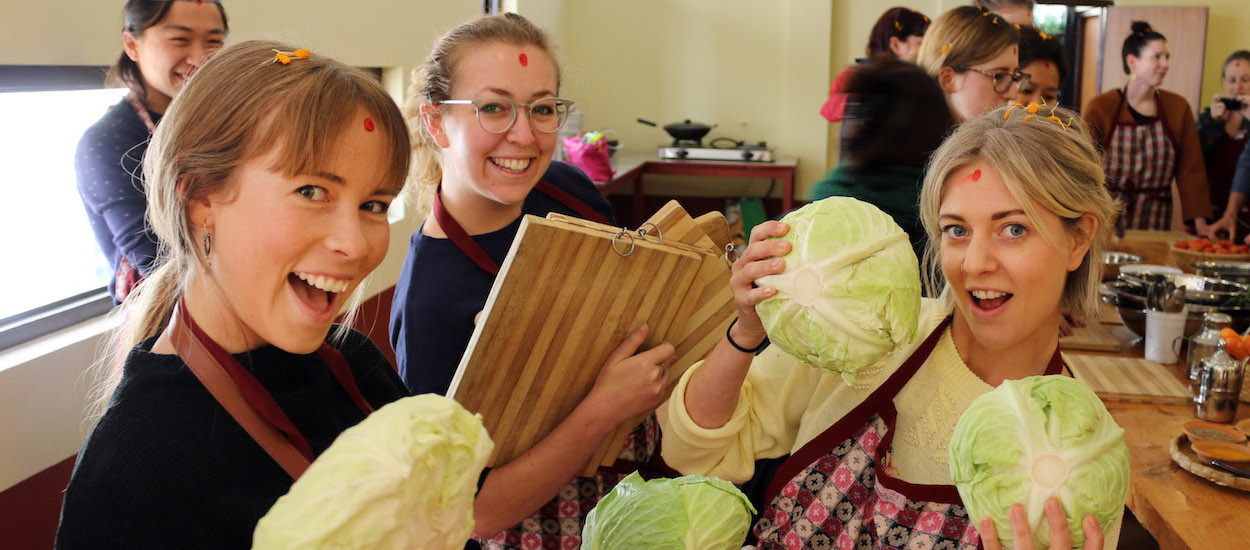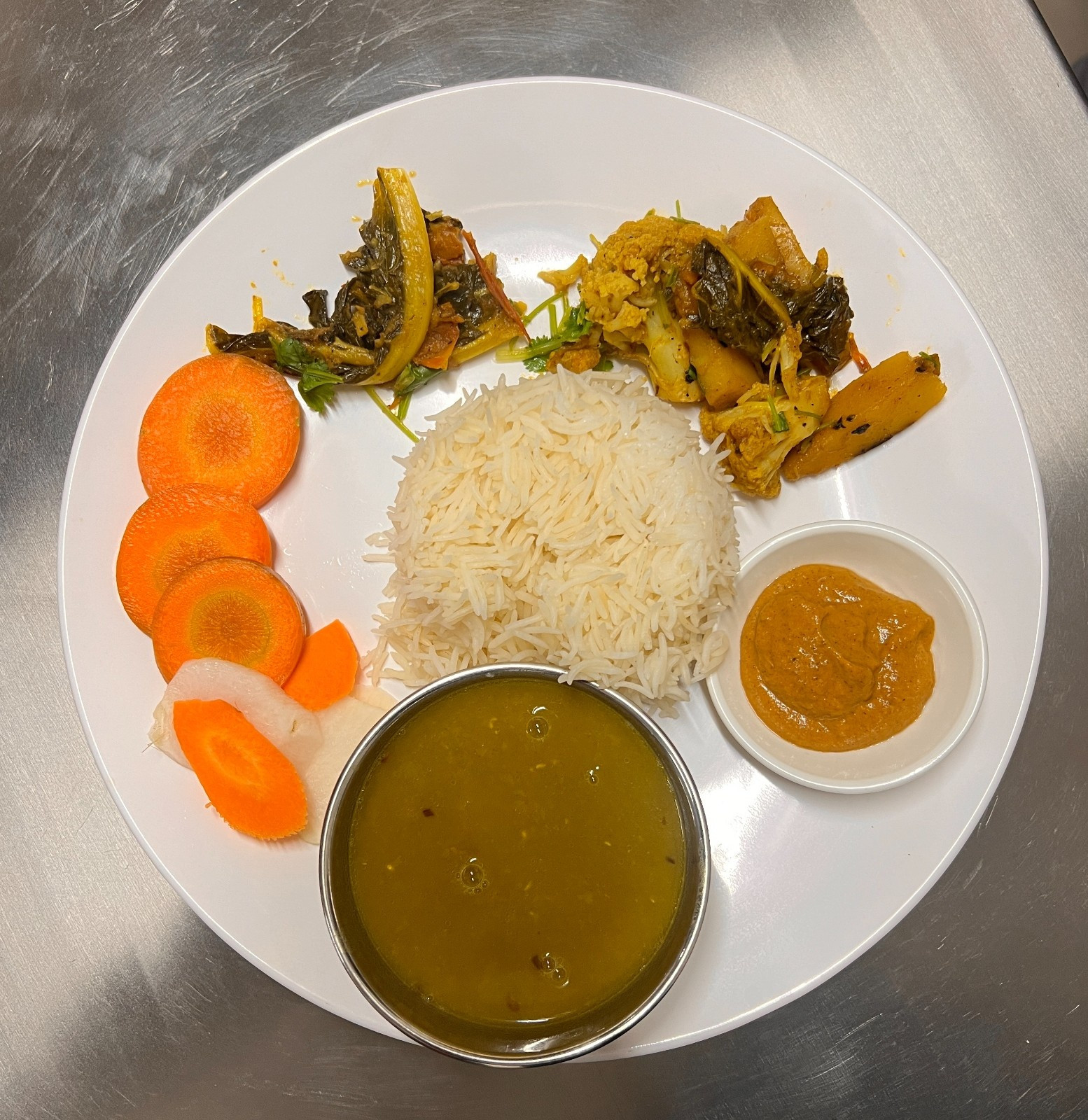Overview
Cooking class in Kathmandu offers an immersive and delectable experience, allowing individuals to explore the essence of Nepalese gastronomy. Nestled within the bustling streets of Nepal's capital, these classes seamlessly blend cultural discovery with culinary craftsmanship. Upon entering a traditional Nepali kitchen, one is greeted by the enticing fragrance of spices and the gracious hospitality of local chefs. Participants are given the opportunity to unravel the mysteries behind iconic Nepali dishes such as momo dumplings, dal bhat (Nepali Staple meal), and aromatic curries, all while utilizing fresh, locally-sourced ingredients. Beyond honing culinary skills, these classes often delve into the cultural significance of each dish, providing a richer understanding of the culinary voyage. Whether you're a novice in the kitchen or a seasoned food enthusiast, a cooking workshop in Kathmandu serves as a delightful gateway to connect with Nepal's flavorful traditions.
Why you need to take Cooking Class in Kathmandu?
The Joy of Learning Cooking Nepali Foods
Envision entering a classic Nepali kitchen, where the ambiance is infused with the delightful scents of spices, and the friendly faces of native chefs welcome you. Kathmandu's cooking workshops present a distinct chance to not just savor but also craft the delectable dishes that have made Nepal renowned. From momo dumplings to dal bhat (Nepal's staple dish), you'll acquire the skills to whip up these iconic delicacies using locally procured, fresh ingredients. It's a hands-on encounter that plunges you deep into the core of Nepali culinary customs.
Discover the Cultural Significance
Nepali food is intricately linked with the nation's culture and legacy. Through a cooking class, you won't just master the art of preparing these dishes but also acquire an understanding of the cultural importance attached to each. Take dal bhat, a fundamental element of Nepali gastronomy, for instance—it signifies not only a meal but also embodies concepts of hospitality and unity. Grasping the cultural background of these culinary traditions enhances the dining encounter in Nepal, adding depth and enrichment.
Take Memories
Although photographs and souvenirs hold their own significance, the expertise and insights acquired from a cooking class become enduring companions. Each time you replicate a Nepali dish in your own kitchen, you're immediately whisked back to your experiences in Nepal, turning it into a lasting gift that continues to enrich your life.
Interactive Culinary Adventure
While exploring Nepali cuisine through literature or dining out is noteworthy, nothing compares to the immersive involvement of crafting it firsthand. With seasoned chefs as mentors, you engage in a tactile encounter, touching, smelling, and feeling the ingredients. This hands-on approach enables you to grasp their importance and master the nuanced interplay of flavors inherent in each dish.
Nepali Cooking Class Menu
Starter
Nepali Masala Tea
Start your Nepali Cooking Class Workshop by tasting Nepali Masala Tea.
Main Course
Choosing menu for a cooking class is an exciting and interactive process that reflects the diverse culinary traditions of the region. Participants are often presented with a variety of options, each showcasing iconic Nepali dishes and flavors. From classic staples like Dal Bhat (lentil soup with rice) and Momo (dumplings) to regional specialties such as Thukpa (noodle soup) and Chhoila (spiced meat); the menu offers a rich tapestry of flavors and textures to explore.
Depending on preferences and dietary restrictions, participants can select a combination of dishes that best suit their tastes, ensuring a personalized and immersive cooking experience with our experienced. With guidance from experienced chefs, participants embark on a culinary journey that not only teaches cooking techniques but also celebrates the cultural heritage and diversity of Nepali cuisine.
Lunch/ Dinner Set (Daal Bhaat- Lentil and Rice)
It is typical Nepali set meal for Lunch and dinner often representing hilly region of Nepal. Dal Bhat is a staple Nepali meal, comprising Lentil Soup (dal), rice (bhat) and Mixed vegetable curry and spinach. Often accompanied by hot and spicy pickles.
MO MO
Momo is a popular Nepali dumpling filled with meat or vegetables, steamed or fried, and served with spicy pickles. It's a must-try street food in Kathmandu!

Thukppa
Thukpa often includes a variety of vegetables such as carrots, cabbage, and spinach, as well as protein sources like chicken, beef, or tofu.
Chatamari
Chatamari, also known as "Nepali pizza", it is topped with a variety of ingredients, typically including minced meat (such as chicken or buffalo), eggs, vegetables (like onions, tomatoes, and green chilies), and a blend of spices
Achhar (Pickle)
Achaar is a South Asian condiment, made from pickled fruits or vegetables. Infused with spices and often tangy or spicy.

Dessert (Sweet Ending)
Carrot Pudding: Sweet delicacy is made from grated carrots, milk, sugar, and ghee (clarified butter), simmered together until the carrots are tender and the mixture thickens.
Yomari: It is a traditional Newari sweet dumpling from Nepal, made of rice flour dough filled with jaggery and sesame seeds. Steamed to perfection, it’s especially popular during the Yomari Punhi festival and loved for its rich taste and cultural significance.
Key Ingredients in Traditional Nepali Cooking
Nepali cuisine is a rich blend of flavors, shaped by the country’s varied geography and cultural diversity. The ingredients used in everyday cooking reflect Nepal’s agricultural abundance and time-honored culinary heritage. To prepare authentic Nepali meals or replicate Nepali kitchen in your home, it’s essential to become familiar with the basic components that form the foundation of this cuisine. Here are the essentials:
Spices:
- Turmeric (Besar): Known for its golden hue and mild earthy flavor, also valued for its health benefits.
- Cumin (Jeera): Adds a warm, nutty aroma and is used both whole and ground.
- Coriander (Dhaniya): Offers a fresh, citrusy taste; used in seed form.
- Fenugreek (Methi): Bitter seeds or leaves often used in pickles and curries.
- Timur: A native spice similar to Szechuan pepper, with a tangy, lemony kick.
- Asafoetida (Hing): A pungent spice used in small amounts to enhance flavor.
- Ginger (Adhuwa) and Garlic (Lasun): Often blended into a paste for the cooking base.
Herbs:
- Coriander Leaves (Dhaniya Patta): Commonly used for garnish and in chutneys.
- Mint (Pudina): Adds freshness to sauces and salads.
Grains and Pulses:
- Rice: A dietary staple, especially as part of Dal Bhat.
- Lentils (Dal): Red, black, and green varieties form the base of many dishes.
- Buckwheat and Millet: Integral in traditional foods like Dhido.
Proteins:
- Meats: Chicken, goat, and buffalo are commonly used.
- Pulses and legumes: Serve as key protein sources for vegetarians.
Vegetables:
- Potatoes (Aloo): Versatile and used in many preparations.
- Leafy Greens: Spinach, mustard greens, and fenugreek are frequently cooked.
- Bamboo Shoots (Tama): Essential in dishes like Aloo Tama.
- Gundruk: Fermented greens rich in flavor and nutrients.
Dairy:
- Ghee: Used for cooking and enhancing flavors.
- Yogurt (Dahi): A staple side dish and ingredient in various meals.
Other Essentials:
- Chilies: Both green and dried varieties add heat and flavor.
- Mustard Oil: A preferred cooking oil with a strong aroma.
- Tamarind and Lime: Used to add a tangy note to dishes.
By stocking your kitchen with these ingredients, you’ll be well-equipped to recreate the traditional flavors of Nepal and bring the culinary essence of the Himalayas into your home.
Nepali Cooking class/ Workshop Shifts
Cooking enthusiasts in Kathmandu can enjoy flexible class timings with three daily sessions available at 9:00 AM, 1:00 PM, and 4:00 PM.
For a hassle-free experience, we also offer optional pick-up and drop-off services. This transfer service is available at an additional cost, and the pick-up time will be shared in advance based on your location.

.JPG)

